3D Coordinates
Polar coordinates for the plane generalize to 3D in two different ways:
- Cylindrical coordinates
- Spherical coordinates
In this overview, we'll meet both of these coordinate systems with a focus on expressing triple integrals
$$\iiint_R f(x,y,z) \, dV$$over regions that are "simple" in those coordinate systems
Cylindrical coordinates
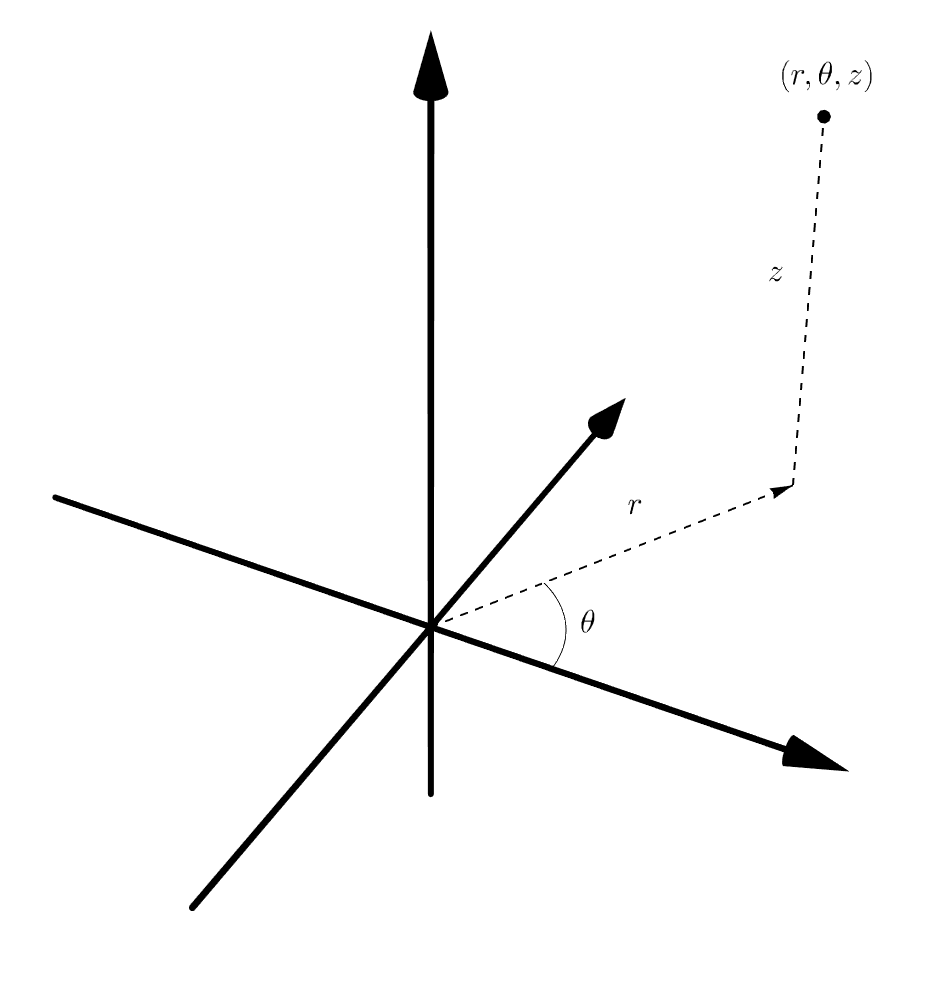
Cylindrical coordinates are like polar+$z$: specify a point in the plane via polar coordinates $(r,z)$, then its vertical displacement using $z$.
Cylindrical coords with xy
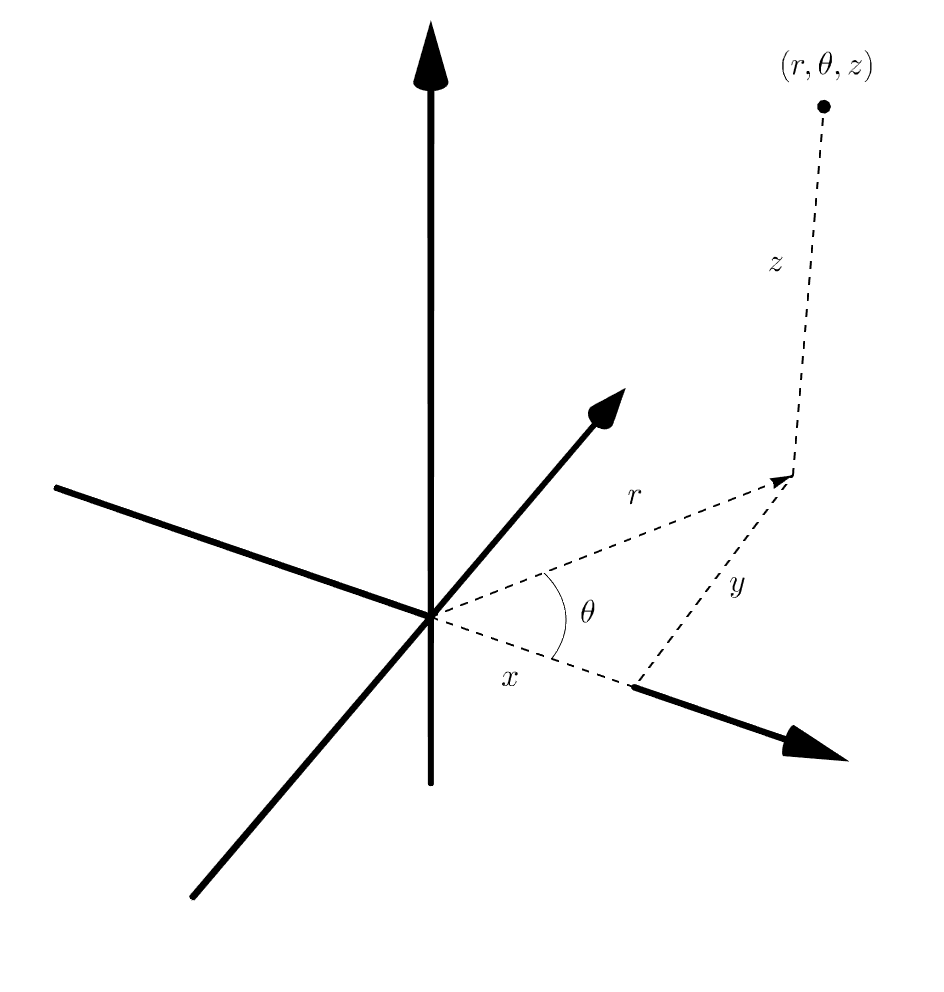
If you put $x$ and $y$ in that picture, then you can see the relationship between cylindrical and Cartesian.
Translation
Given $f(x,y,z)$, we can derive $F(r,\theta,z)$ using
$$\begin{align} x &= r\cos(\theta) \\ y &= r\sin(\theta) \\ z &= z. \end{align}$$That is, $F(r,\theta,z) = f(r\cos(\theta),r\sin(\theta), z)$.
Examples
If $f(x,y,z) = x^2 - \sin(yz)$, then $$F(r,\theta,z) = r^2\cos^2(\theta) - \sin(r\sin(\theta)z).$$
Any $x^2+y^2$ can be replaced with $r^2$. For example, if $f(x,y,z)=(4-(x^2+y^2))z$, then $$F(r,\theta,z) = (4-r^2)z.$$
Triple integrals in cylindrical coordinates
We can express a triple integral in cylindrical coordinates as follows:
$$\color{green}{\iiint_R} \color{blue}{f(x,y,z)} \, \color{red}{dV} = \color{green}{\int_{\alpha}^{\beta} \int_c^d \int_a^b} \color{blue}{f(r\cos(\theta),r\sin(\theta),z)} \, \color{red}{r \, dr \, dz \, d\theta}$$As with polar coordinates and general change of variables, we need to translate the bounds of integration, the function, and the volume element. Note that the $r$ is part of the volume element $dV$, just as in polar coordinates.
Simple cylindrical regions
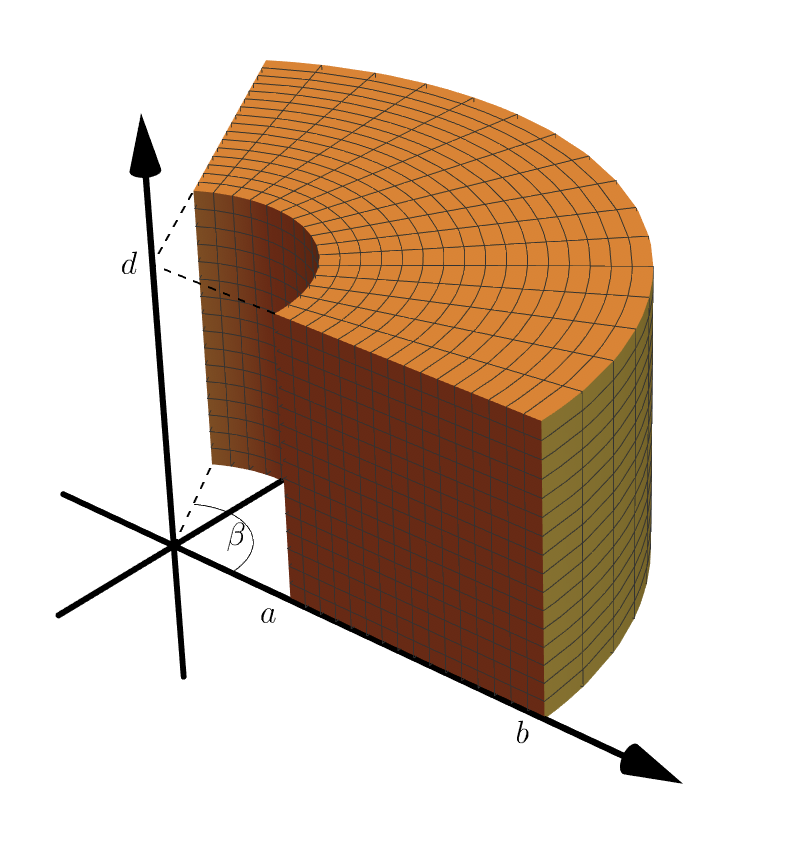
The "simplest" regions in cylindrical coordinates have the form
$$a\leq r \leq b, \: \alpha\leq\theta\leq\beta, \: c\leq z \leq d.$$Such a region (where $\alpha=c=0$) is shown above.
A functional bound
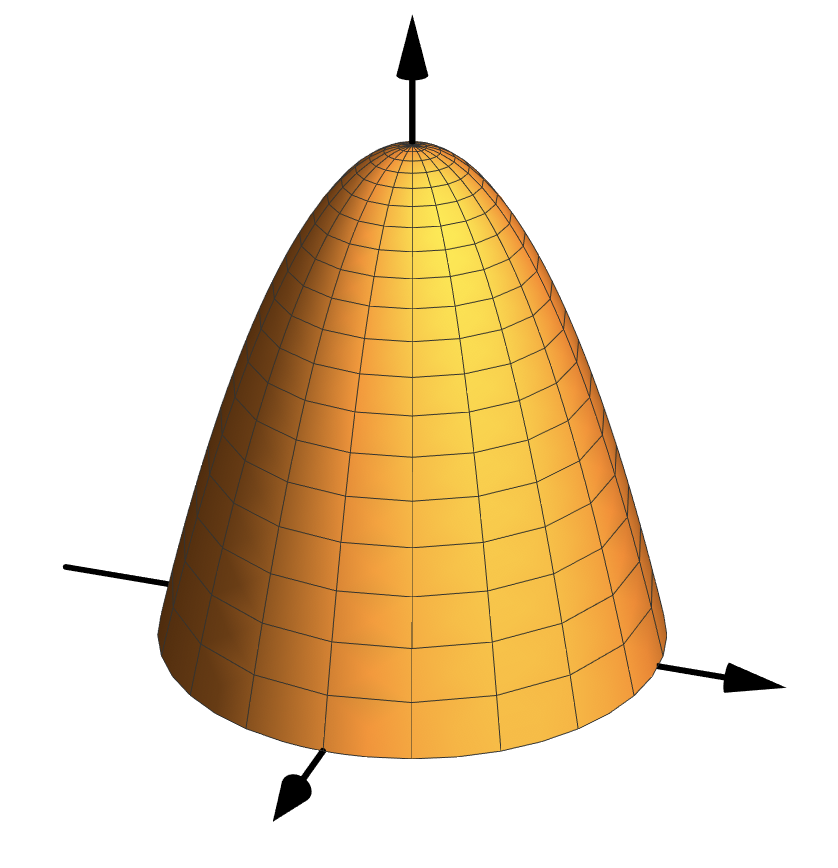
Sometimes, we might want to bound the top or bottom with a function. The region above can be described by
$$0\leq r \leq 2, \: 0\leq\theta\leq2\pi, \: 0\leq z \leq 4-r^2.$$Example
Set up $\iiint_R (x^2+y^2 + z) \, dV$ as an iterated integral in cylindrical coordinates, where $R$ is the region on the previous slide.
Solution:
$$\int_0^{2\pi} \int_0^2 \int_0^{4-r^2} (r^2+z)\,r\,dz\,dr\,d\theta = \frac{64}{3}\pi.$$Spherical coordinates
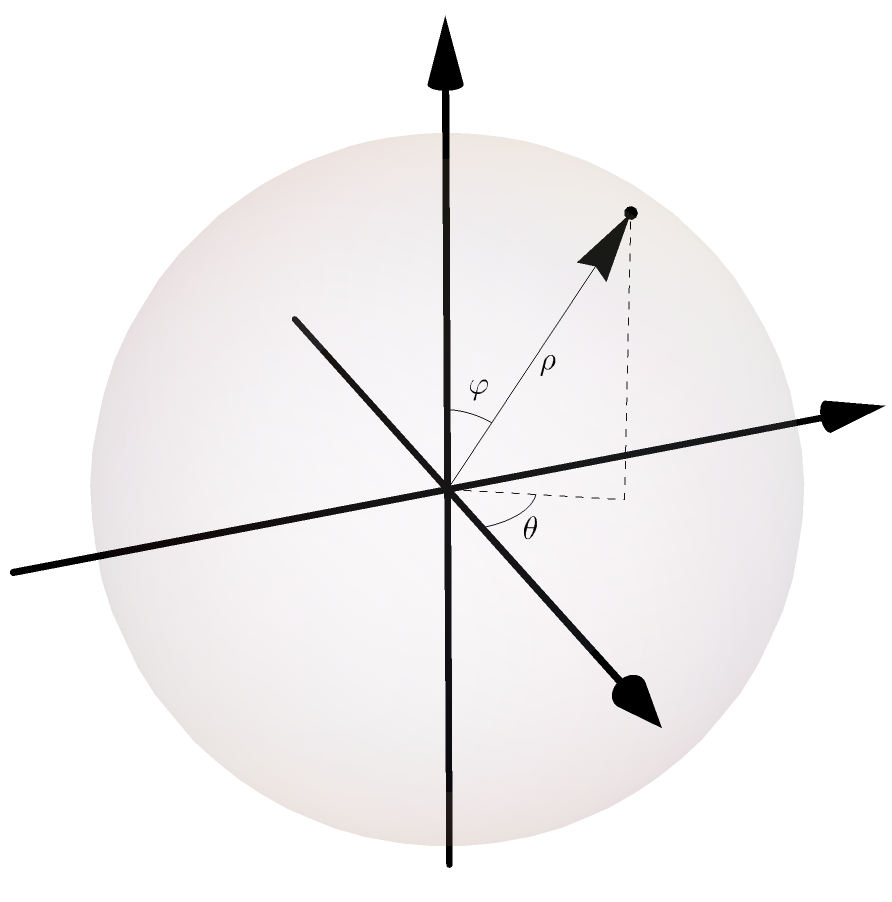
- $\rho$ represents distance to the origin,
- $\varphi$ represents angle from the positive $z$ axis,
- $\theta$ is the polar coordinate $\theta$.
Spherical to Cylindrical
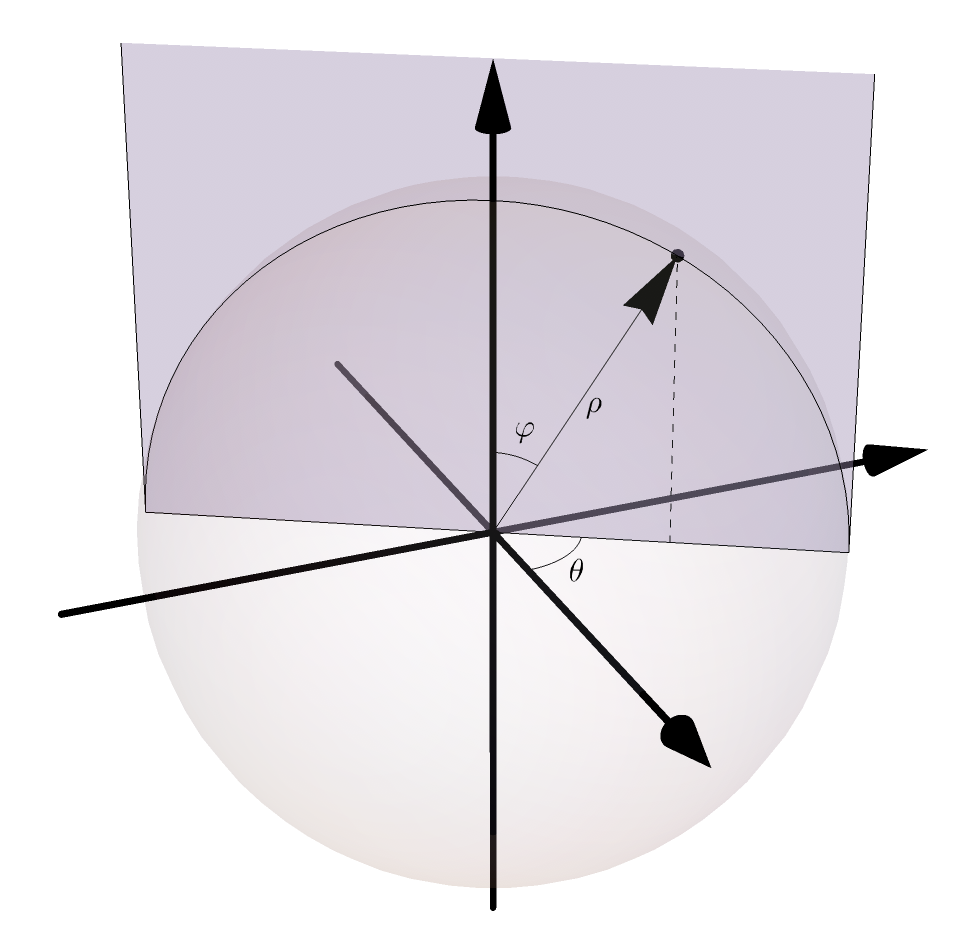
To translate spherical coordinates to cylindrical, we first fix $\theta$ to determine a plane in which we can relate $\rho$ and $\varphi$ to $r$ and $z$.
Spherical to Cylindrical (cont)

Once we look at just that triangle in a plane, it's easy to read off the relationships in terms of the trig functions.
Spherical to Cartesian
We can now use cylindrical coordinates as an intermediate step to translate Cartesian to spherical.
$$\begin{align} x &= r\cos(\theta) = \rho\sin(\varphi)\cos(\theta)\\ y &= r\sin(\theta) = \rho\sin(\varphi)\sin(\theta)\\ z &= z = \rho\cos(\varphi)\\ \end{align}$$Any $(x^2+y^2+z^2)$s that we see can be replaced by $\rho^2$.
Triple integrals in spherical coordinates
We can express a triple integral in spherical coordinates as follows:
$$\color{green}{\iiint_R} \color{blue}{f(x,y,z)} \, \color{red}{dV} \\ = \color{green}{\int_{\alpha}^{\beta} \int_{\gamma}^{\delta} \int_a^b} \color{blue}{f(\rho\sin(\varphi)\cos(\theta),\rho\sin(\varphi)\sin(\theta),\rho\cos(\varphi))} \, \color{red}{\rho^2 \sin(\phi) \, d\rho \, d\phi \, d\theta}$$Again, we need to translate the bounds of integration, the function, and the volume element. Now, a $\rho^2\sin(\varphi)$ appears as part of $dV$.
Simple spherical regions
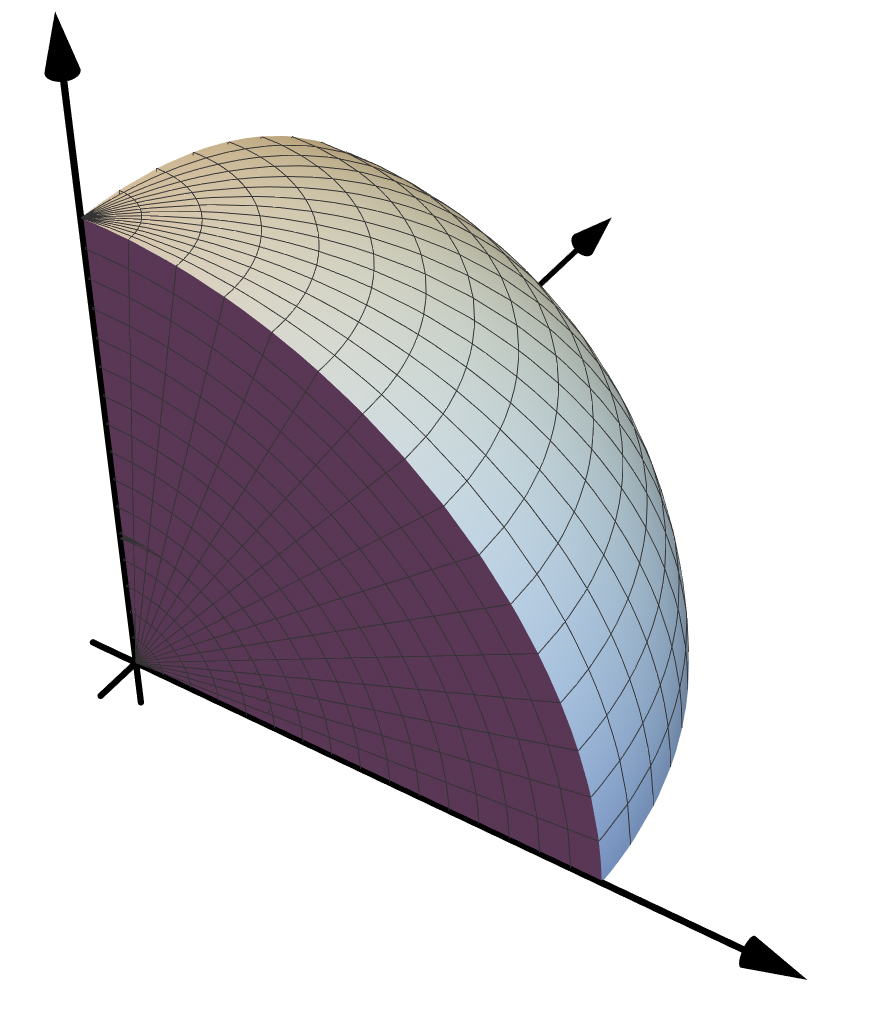
The "simplest" regions in spherical coordinates have the form
$$\alpha\leq \theta \leq \beta, \: \gamma\leq\varphi\leq\delta, \: a\leq \rho \leq b.$$Such a region is shown above.
The volume element
So where's $dV = \rho^2\sin(\varphi)\,d\rho\,d\varphi\,d\theta$ come from? Referring to the spherical coordinate transformations, we can write out the Jacobian:
$$\left|\begin{matrix} \partial x/\partial\rho & \partial x/\partial\varphi & \partial x/\partial\theta \\ \partial y/\partial\rho & \partial y/\partial\varphi & \partial y/\partial\theta \\ \partial z/\partial\rho & \partial z/\partial\varphi & \partial z/\partial\theta \\ \end{matrix}\right| = \left|\begin{matrix} \sin(\varphi)\cos(\theta) & \sin(\varphi)\sin(\theta) & \cos(\varphi) \\ \rho\cos(\varphi)\cos(\theta) & \rho\cos(\varphi)\sin(\theta) & -\rho\sin(\varphi) \\ -\rho\sin(\varphi)\sin(\theta) & \rho\sin(\varphi)\cos(\theta) & 0 \end{matrix}\right|$$Since it's super long, I'll have WolframAlpha work it out; which should return a result that looks like this.
Example
Let's compute the mass of a sphere $S$ of radius 1 with density function $f(x,y,z)=2-(x^2+y^2+z^2)$; thus, this object is most massive at its center becoming less so as we move to it's edge. The density should be:
$$\begin{align} \iiint_S (2-(x^2+y^2+z^2)) \, dV &= \int_0^{2\pi} \int_0^{\pi} \int_0^1 (2-\rho^2)\rho^2 \sin(\varphi) \, d\rho \, d\varphi \, d\theta \\ &= 2\pi \int_0^{\pi} \int_0^1 (2\rho^2 - \rho^4) \sin(\varphi) \, d\rho \, d\varphi \\ &= 2\pi \color{lightgray}\times 2\,\left(\frac{2}{3}-\frac{1}{5}\right). \end{align}$$